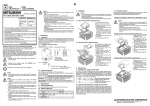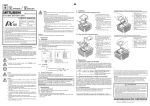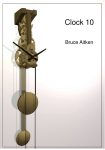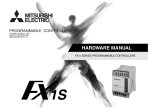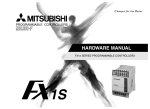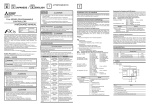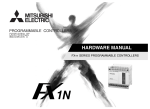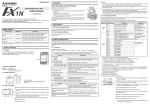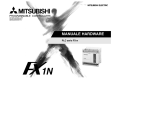Download FX1N-BAT BATTERY UNIT USER`S MANUAL
Transcript
JY997D10201C Side B Side A Side B JAPANESE ENGLISH 1.1.2 Caution • Units should not be installed in areas subject to the following conditions: excessive or conductive dust, corrosive or flammable gas, moisture or rain, excessive heart, regular impact shocks or excessive vibration. • Cut off all phases from the power source before installation or maintenance work to avoid electric shock. Incorrect operation can lead to serious damage to the product. • Use the screwdriver in the correct position when removing the FX1N-BAT. If the screwdriver slips, it is likely to result in injury. • To avoid electric shock, replace the top cover, after installation or wiring work is completed, and before supplying power and operating the unit. • Securely install the FX1N-BAT in the fixed connector. When installed incorrectly, the PLC will malfunction due to faulty contacts. • Do not disassemble or modify the module. Doing so may result in failure, malfunction, injury, or fire. • The module case is made of resin; do not drop it or subject it to strong shock. Doing so may damage the module. • When disposing of this product, treat it as industrial waste. When disposing of batteries, separate them from other waste according to local regulations. (For details of the Battery Directive in EU countries, refer to [Chapter6. Handling of Batteries and Devices with Built-in Batteries in EU Member States].) • When the FX1N-BAT is transported attached to a PLC and the life cycle has passed or the BATT.V LED turns ON when the PLC is powered, the data backed up by the capacitor will have become random. Check the following two points before transporting the installed FX1NBAT attached to the FX1N series PLC. - Life cycle of FX1N-BAT - BATT.V" LED of FX1N-BAT is OFF when the FX1N series PLC is powered up. • During transportation avoid any impact as the PLC is a precision instrument. It is necessary to check the operation of PLC after transportation, in case of any impact damage. • During transportation avoid any impact to the battery (FX1N-BAT) as the PLC may be seriously damaged by liquid leakage etc. from the battery. • When transporting lithium batteries, follow required transportation regulations. (For details of the regulated products, refer to [Chapter5. Precautions for Battery Transportation].) FX1N-BAT BATTERY UNIT USER'S MANUAL C Date October 2010 • This manual contains text, diagrams and explanations which guide the reader in the correct installation and operation of the FX1N-BAT battery unit. It should be read and understood before attempting to use the unit. • Further information for the FX1N series PLC can be found in the FX1N Series Hardware Manual. • If in doubt at any stage of the installation of FX1N-BAT, consult a professional electrical technician who is qualified and trained to the local and national standards which apply to the installation site. • If in doubt about the operation or use of the FX1N-BAT please consult the nearest Mitsubishi Electric distributor. • This manual is subject to change without notice. • The company name and the product name described in this manual are the registered trademarks or trademarks of each company. © 2003 Mitsubishi Electric Corporation Guideline for the safety of the user and protection of the FX1N-BAT. This manual provides usage information for the FX1N-BAT Battery Unit. The manual has been written to be used by trained and competent personnel. Note's on the symbols used in this manual At various times throughout out this manual certain symbols will be used to highlight points of information which are intended to ensure the users personal safety and protect the integrity of equipment. Whenever any of the following symbols are encountered, its associated note must be read and understood. Each of the symbols used will now be listed with a brief description of its meaning. Hardware Warnings 2)Indicates that the identified danger could POSSIBLY cause physical and property damage. 3)Indicates a point of further interest or further explanation. Danger • Perform cleaning of the module only after turning OFF all external power supplies. Failure to do so may cause failure or malfunction of the modules. • Use the battery for memory backup correctly in this manual. - Use the battery only for the specified purpose. - Connect the battery correctly. - Do not charge, disassemble, heat, put in fire, short-circuit, connect reversely, weld, swallow or burn the battery, or apply excessive forces (vibration, impact, drop, etc.) to the battery. - Do not store or use the battery at high temperatures or expose to direct sunlight. - Do not expose to water, bring near fire or touch liquid leakage or other contents directly. - Incorrect handling of the battery may cause heat excessive generation, bursting, ignition, liquid leakage or deformation, and lead to injury, fire or failures and malfunctions of facilities and other equipment. Standard Please consult with Mitsubishi Electric for applicable standards. Attention • This product is designed for use in industrial applications. Note • Manufactured by: Mitsubishi Electric Corporation 2-7-3 Marunouchi, Chiyoda-ku, Tokyo, 100-8310 Japan • Manufactured at: Mitsubishi Electric Corporation Himeji Works 840 Chiyoda-machi, Himeji, Hyogo, 670-8677 Japan • Authorized Representative in the European Community: Mitsubishi Electric Europe B.V. Gothaer Str. 8, 40880 Ratingen, Germany The FX1N-BAT Battery Unit (hereinafter referred to as the FX1N-BAT) is installed on the FX1N PLC to ensure that the capacitor-backed devices and clock data do not become random values when power is not supplied to the PLC for a long time (10 days or more) during transportation, etc. The FX1N-BAT should be used within its expiration date (life cycle: 2 years at 25°C). 1.1.1 Dimensions and Each Part Name Unit: mm (inches) Accessory: Top cover for FX1N-BAT × 1, M3 screw to fix top cover × 1 40 (1.58") 3) 11.3 3) (0.45") 1) 1) Supply power to the PLC for 30 minutes or more. 2) Turn Off the power to the PLC. 3) Remove the FX1N-BAT holding it while pressing (A) as shown in the figure on the left. 4) Install the new FX1N-BAT onto the PLC. 5) Turn On the power to the PLC. 4) 2) For installation of the expansion board, refer to the FX1N Hardware Manual. 1) Turn Off the power to the PLC. 2) Remove the top cover of the expansion board. 3) Remove section (A) with wirecutters to expose the connector. 4) Attach the top cover of the expansion board. 5) Secure the top cover to the PLC with screw (B). The screw should be tightened with a torque of 0.3 to 0.6 N•m. The screw must be secured to prevent malfunction due to a loose connection. 6) Fix the FX1N-BAT to connector (C) on the expansion board. 7) Turn On the power to the PLC. Z Month (Example: Dec): 1 to 9 = Jan to Sept, X = Oct, Y = Nov, Z = Dec Year (Example: 2009) Last digit of year (C) (A) (B) <Product from January, 2010> LOT. 1 0 1 Month (Example: Jan): 1 to 9 = Jan to Sept, X = Oct, Y = Nov, Z = Dec Year (Example: 2010) Last two digit of year 1.2 System Configuration One FX1N-BAT can be installed on an FX1N series main unit. (FX1N-BAT cannot be installed on an FX1S series main unit.) The FX1N-BAT can be used with an expansion board. See the following table for possible configurations. Expansion Board / Display Module / Memory Cassette Using with FX1N-232-BD, FX1N-422-BD,FX1N-485-BD, FX1N-CNV-BD, FX1N-8AV-BD, FX1N-4EX-BD, FX1N-2EYT-BD Not using with FX1N-2AD-BD, FX1N-1DA-BD, FX1N-5DM, FX1N-EEPROM-8L 2. Specifications 4. Maintenance 4.1 Detecting Low voltage in the FX1N-BAT The "BATT.V" LED of the FX1N-BAT lights when the low voltage is detected on power-up of the FX1N series PLC. It is possible to output the status of the "BATT.V" LED to an output terminal on the PLC with the following programs. Move K into D8159 to enable M(+4) to turn ON when the FX1N-BAT voltage becomes low. Note that M-M(+15) are also occupied for the low voltage detection. Therefore, these devices should not be used for other applications. M8002 2.1 General Specifications MOV The general specifications are equivalent to those of the FX1N main unit. The devices in the table below are backed up by the FX1N-BAT. • Capacitor-backed device (M512 - M1535, S128 - S999, T246 - T255, C32 - C199, C220 - 234, D256 - D7999) • Current time 3. Installation 3.1 When not used with an expansion board (B) (A) (C) K0 D8159 Moving K0 into D8159 will occupy the flags, M0 to M15, for detecting low voltage in the FX 1N-BAT. Y0 When the FX1N-BAT experiences low voltage, M4 is turned ON. M4 2.2 Subject of Backed-up 1.1 Introduction FX1N-BAT Exchange Procedure - When used with an expansion board - LOT. 9 1. Introduction 32(1.26") 1)Indicates that the identified danger WILL cause physical and property damage. 3VDC Revision LOT.101 JY997D10201 FX1N-BAT Manual Number 3.2 When used with an expansion board Lot Number <Product during December, 2009 or earlier> 1) Turn Off the power to the PLC. 2) Remove the top cover of the PLC. 3) Attach the top cover (A) of the FX1N-BAT accessory. 4) Secure the top cover (A) to the PLC with a screw (B). The screw should be tightened with a torque of 0.3 to 0.6 N • m. The screw must be secured to prevent malfunction due to a loose connection. 5) Fix the FX1N-BAT to connector (C) on the PLC. 6) Turn On the power to the PLC. 4.2 Operation After Detecting Low Voltage in the FX1N-BAT The "BATT.V" LED of FX1N-BAT lights when low voltage is detected on power-up of the FX1N series PLC. Ten days after the "BATT.V" LED lights, the capacitor inside the PLC will begin to back up the devices with whatever charge was present at the last power down of the PLC. It is necessary to power-up the PLC every ten days, for a period of 30 minutes, to recharge the capacitor after the FX1N-BAT is no longer backing up the devices. If power is not supplied for ten days or more, the capacitor-backed data will become random. Further information concerning the capacitor backup can be found in FX1N Hardware Manual. 4.3 Exchange Procedure When the "BATT.V" LED of the FX1N-BAT lights, do not leave the PLC unpowered for 10 days or more until the FX1N-BAT is exchanged to the new one. For the operation after detecting low voltage, refer to section 4.2. Life cycle of FX1N-BAT: 2 years at 25 °C Exchange Procedure - When not used with an expansion board 1) Supply power to the PLC for 30 minutes or more. 2) Turn Off the power to the PLC. 3) Put screwdriver at the right side of FX1N-BAT as shown in the figure on the left. 4) Go a little up FX1N-BAT by operating the screwdriver as shown in the figure on the left. 5) Remove the FX1N-BAT holding i t as s hown in the figure on the left. 6) Install the new FX1N-BAT onto the PLC. 7) Turn On the power to the PLC. 1) BATT.V LED 2) Hook for fixation 3) Connector for PLC 4) Product name and Lot number POINT The requirements apply to batteries and/or devices with built-in batteries manufactured before the enforcement date of the new EU Battery Directive (2006/66/EC). 6.3 Regulated products Product name Battery type FX1N-BAT Lithium Manganese Dioxide (A) 5. Precautions for Battery Transportation When transporting lithium batteries, follow the transportation regulations. 5.1 Regulated products Product name Battery type Product supply status Lithium Content (gram/unit) Mass (gram/unit)*1 FX1N-BAT Lithium metal battery Battery 0.07 30 *1 The value indicates the mass with packaging 5.2 Transport guidelines Comply with IATA Dangerous Goods Regulations, IMDG code and the local transport regulations when transporting products listed above. Also, consult with the shipping carrier. 6. Handling of Batteries and Devices with Built-in Batteries in EU Member States This section describes the precautions for disposing of waste batteries in EU member states and exporting batteries and/or devices with built-in batteries to EU member states. 6.1 Disposal precautions In EU member states, there is a separate collection system for waste batteries. Dispose of batteries properly at the local community waste collection/recycling center. The symbol shown in following figure is printed on the batteries and packaging of batteries and devices with built-in batteries used for Mitsubishi programmable controllers. for battery EU This manual confers no industrial property rights or any rights of any other kind, nor does it confer any patent licenses. Mitsubishi Electric Corporation cannot be held responsible for any problems involving industrial property rights which may occur as a result of using the contents noted in this manual. *1 This symbol is for EU member states only. The symbol is specified in the new EU Battery Directive (2006/66/EC) Article 20 "Information for end-users" and Annex II. The symbol indicates that batteries need to be disposed of separately from other wastes. 6.2 Exportation precautions The new EU Battery Directive (2006/66/EC) requires the follwoing when marketing or exporting batteries and/or devices with built-in batteries to EU member states. • To print the symbol on batteries, devices, or their packaging • To explain the symbol in the manuals of the products 1) Labelling To market or export batteries and/or devices with built-in batteries, which have no symbol, to EU member states on September 26, 2008 or later, print the symbol shown in the figure above on the batteries, devices, or their packaging. 2) Explaining the symbol in the manuals To export devices incorporating Mitsubishi programmable controller to EU member states on September 26, 2008 or later, provide the latest manuals that include the explanation of the symbol. If no Mitsubishi manuals or any old manuals without the explanation of the symbol are provided, separately attach an explanatory note regarding the symbol to each manual of the devices. Warranty Mitsubishi will not be held liable for damage caused by factors found not to be the cause of Mitsubishi; machine damage or lost profits caused by faults in the Mitsubishi products; damage, secondary damage, accident compensation caused by special factors unpredictable by Mitsubishi; damages to products other than Mitsubishi products; and to other duties. For safe use • This product has been manufactured as a general-purpose part for general industries, and has not been designed or manufactured to be incorporated in a device or system used in purposes related to human life. • Before using the product for special purposes such as nuclear power, electric power, aerospace, medicine or passenger movement vehicles, consult with Mitsubishi Electric. • This product has been manufactured under strict quality control. However when installing the product where major accidents or losses could occur if the product fails, install appropriate backup or failsafe functions in the system. HEAD OFFICE : TOKYO BUILDING, 2-7-3 MARUNOUCHI, CHIYODA-KU, TOKYO 100-8310, JAPAN HIMEJI WORKS : 840, CHIYODA CHO, HIMEJI, JAPAN JY997D10201C Side B Side A Side B JAPANESE ENGLISH 1.1.2 Caution • Units should not be installed in areas subject to the following conditions: excessive or conductive dust, corrosive or flammable gas, moisture or rain, excessive heart, regular impact shocks or excessive vibration. • Cut off all phases from the power source before installation or maintenance work to avoid electric shock. Incorrect operation can lead to serious damage to the product. • Use the screwdriver in the correct position when removing the FX1N-BAT. If the screwdriver slips, it is likely to result in injury. • To avoid electric shock, replace the top cover, after installation or wiring work is completed, and before supplying power and operating the unit. • Securely install the FX1N-BAT in the fixed connector. When installed incorrectly, the PLC will malfunction due to faulty contacts. • Do not disassemble or modify the module. Doing so may result in failure, malfunction, injury, or fire. • The module case is made of resin; do not drop it or subject it to strong shock. Doing so may damage the module. • When disposing of this product, treat it as industrial waste. When disposing of batteries, separate them from other waste according to local regulations. (For details of the Battery Directive in EU countries, refer to [Chapter6. Handling of Batteries and Devices with Built-in Batteries in EU Member States].) • When the FX1N-BAT is transported attached to a PLC and the life cycle has passed or the BATT.V LED turns ON when the PLC is powered, the data backed up by the capacitor will have become random. Check the following two points before transporting the installed FX1NBAT attached to the FX1N series PLC. - Life cycle of FX1N-BAT - BATT.V" LED of FX1N-BAT is OFF when the FX1N series PLC is powered up. • During transportation avoid any impact as the PLC is a precision instrument. It is necessary to check the operation of PLC after transportation, in case of any impact damage. • During transportation avoid any impact to the battery (FX1N-BAT) as the PLC may be seriously damaged by liquid leakage etc. from the battery. • When transporting lithium batteries, follow required transportation regulations. (For details of the regulated products, refer to [Chapter5. Precautions for Battery Transportation].) FX1N-BAT BATTERY UNIT USER'S MANUAL C Date October 2010 • This manual contains text, diagrams and explanations which guide the reader in the correct installation and operation of the FX1N-BAT battery unit. It should be read and understood before attempting to use the unit. • Further information for the FX1N series PLC can be found in the FX1N Series Hardware Manual. • If in doubt at any stage of the installation of FX1N-BAT, consult a professional electrical technician who is qualified and trained to the local and national standards which apply to the installation site. • If in doubt about the operation or use of the FX1N-BAT please consult the nearest Mitsubishi Electric distributor. • This manual is subject to change without notice. • The company name and the product name described in this manual are the registered trademarks or trademarks of each company. © 2003 Mitsubishi Electric Corporation Guideline for the safety of the user and protection of the FX1N-BAT. This manual provides usage information for the FX1N-BAT Battery Unit. The manual has been written to be used by trained and competent personnel. Note's on the symbols used in this manual At various times throughout out this manual certain symbols will be used to highlight points of information which are intended to ensure the users personal safety and protect the integrity of equipment. Whenever any of the following symbols are encountered, its associated note must be read and understood. Each of the symbols used will now be listed with a brief description of its meaning. Hardware Warnings 2)Indicates that the identified danger could POSSIBLY cause physical and property damage. 3)Indicates a point of further interest or further explanation. Danger • Perform cleaning of the module only after turning OFF all external power supplies. Failure to do so may cause failure or malfunction of the modules. • Use the battery for memory backup correctly in this manual. - Use the battery only for the specified purpose. - Connect the battery correctly. - Do not charge, disassemble, heat, put in fire, short-circuit, connect reversely, weld, swallow or burn the battery, or apply excessive forces (vibration, impact, drop, etc.) to the battery. - Do not store or use the battery at high temperatures or expose to direct sunlight. - Do not expose to water, bring near fire or touch liquid leakage or other contents directly. - Incorrect handling of the battery may cause heat excessive generation, bursting, ignition, liquid leakage or deformation, and lead to injury, fire or failures and malfunctions of facilities and other equipment. Standard Please consult with Mitsubishi Electric for applicable standards. Attention • This product is designed for use in industrial applications. Note • Manufactured by: Mitsubishi Electric Corporation 2-7-3 Marunouchi, Chiyoda-ku, Tokyo, 100-8310 Japan • Manufactured at: Mitsubishi Electric Corporation Himeji Works 840 Chiyoda-machi, Himeji, Hyogo, 670-8677 Japan • Authorized Representative in the European Community: Mitsubishi Electric Europe B.V. Gothaer Str. 8, 40880 Ratingen, Germany The FX1N-BAT Battery Unit (hereinafter referred to as the FX1N-BAT) is installed on the FX1N PLC to ensure that the capacitor-backed devices and clock data do not become random values when power is not supplied to the PLC for a long time (10 days or more) during transportation, etc. The FX1N-BAT should be used within its expiration date (life cycle: 2 years at 25°C). 1.1.1 Dimensions and Each Part Name Unit: mm (inches) Accessory: Top cover for FX1N-BAT × 1, M3 screw to fix top cover × 1 40 (1.58") 3) 11.3 3) (0.45") 1) 1) Supply power to the PLC for 30 minutes or more. 2) Turn Off the power to the PLC. 3) Remove the FX1N-BAT holding it while pressing (A) as shown in the figure on the left. 4) Install the new FX1N-BAT onto the PLC. 5) Turn On the power to the PLC. 4) 2) For installation of the expansion board, refer to the FX1N Hardware Manual. 1) Turn Off the power to the PLC. 2) Remove the top cover of the expansion board. 3) Remove section (A) with wirecutters to expose the connector. 4) Attach the top cover of the expansion board. 5) Secure the top cover to the PLC with screw (B). The screw should be tightened with a torque of 0.3 to 0.6 N•m. The screw must be secured to prevent malfunction due to a loose connection. 6) Fix the FX1N-BAT to connector (C) on the expansion board. 7) Turn On the power to the PLC. Z Month (Example: Dec): 1 to 9 = Jan to Sept, X = Oct, Y = Nov, Z = Dec Year (Example: 2009) Last digit of year (C) (A) (B) <Product from January, 2010> LOT. 1 0 1 Month (Example: Jan): 1 to 9 = Jan to Sept, X = Oct, Y = Nov, Z = Dec Year (Example: 2010) Last two digit of year 1.2 System Configuration One FX1N-BAT can be installed on an FX1N series main unit. (FX1N-BAT cannot be installed on an FX1S series main unit.) The FX1N-BAT can be used with an expansion board. See the following table for possible configurations. Expansion Board / Display Module / Memory Cassette Using with FX1N-232-BD, FX1N-422-BD,FX1N-485-BD, FX1N-CNV-BD, FX1N-8AV-BD, FX1N-4EX-BD, FX1N-2EYT-BD Not using with FX1N-2AD-BD, FX1N-1DA-BD, FX1N-5DM, FX1N-EEPROM-8L 2. Specifications 4. Maintenance 4.1 Detecting Low voltage in the FX1N-BAT The "BATT.V" LED of the FX1N-BAT lights when the low voltage is detected on power-up of the FX1N series PLC. It is possible to output the status of the "BATT.V" LED to an output terminal on the PLC with the following programs. Move K into D8159 to enable M(+4) to turn ON when the FX1N-BAT voltage becomes low. Note that M-M(+15) are also occupied for the low voltage detection. Therefore, these devices should not be used for other applications. M8002 2.1 General Specifications MOV The general specifications are equivalent to those of the FX1N main unit. The devices in the table below are backed up by the FX1N-BAT. • Capacitor-backed device (M512 - M1535, S128 - S999, T246 - T255, C32 - C199, C220 - 234, D256 - D7999) • Current time 3. Installation 3.1 When not used with an expansion board (B) (A) (C) K0 D8159 Moving K0 into D8159 will occupy the flags, M0 to M15, for detecting low voltage in the FX 1N-BAT. Y0 When the FX1N-BAT experiences low voltage, M4 is turned ON. M4 2.2 Subject of Backed-up 1.1 Introduction FX1N-BAT Exchange Procedure - When used with an expansion board - LOT. 9 1. Introduction 32(1.26") 1)Indicates that the identified danger WILL cause physical and property damage. 3VDC Revision LOT.101 JY997D10201 FX1N-BAT Manual Number 3.2 When used with an expansion board Lot Number <Product during December, 2009 or earlier> 1) Turn Off the power to the PLC. 2) Remove the top cover of the PLC. 3) Attach the top cover (A) of the FX1N-BAT accessory. 4) Secure the top cover (A) to the PLC with a screw (B). The screw should be tightened with a torque of 0.3 to 0.6 N • m. The screw must be secured to prevent malfunction due to a loose connection. 5) Fix the FX1N-BAT to connector (C) on the PLC. 6) Turn On the power to the PLC. 4.2 Operation After Detecting Low Voltage in the FX1N-BAT The "BATT.V" LED of FX1N-BAT lights when low voltage is detected on power-up of the FX1N series PLC. Ten days after the "BATT.V" LED lights, the capacitor inside the PLC will begin to back up the devices with whatever charge was present at the last power down of the PLC. It is necessary to power-up the PLC every ten days, for a period of 30 minutes, to recharge the capacitor after the FX1N-BAT is no longer backing up the devices. If power is not supplied for ten days or more, the capacitor-backed data will become random. Further information concerning the capacitor backup can be found in FX1N Hardware Manual. 4.3 Exchange Procedure When the "BATT.V" LED of the FX1N-BAT lights, do not leave the PLC unpowered for 10 days or more until the FX1N-BAT is exchanged to the new one. For the operation after detecting low voltage, refer to section 4.2. Life cycle of FX1N-BAT: 2 years at 25 °C Exchange Procedure - When not used with an expansion board 1) Supply power to the PLC for 30 minutes or more. 2) Turn Off the power to the PLC. 3) Put screwdriver at the right side of FX1N-BAT as shown in the figure on the left. 4) Go a little up FX1N-BAT by operating the screwdriver as shown in the figure on the left. 5) Remove the FX1N-BAT holding i t as s hown in the figure on the left. 6) Install the new FX1N-BAT onto the PLC. 7) Turn On the power to the PLC. 1) BATT.V LED 2) Hook for fixation 3) Connector for PLC 4) Product name and Lot number POINT The requirements apply to batteries and/or devices with built-in batteries manufactured before the enforcement date of the new EU Battery Directive (2006/66/EC). 6.3 Regulated products Product name Battery type FX1N-BAT Lithium Manganese Dioxide (A) 5. Precautions for Battery Transportation When transporting lithium batteries, follow the transportation regulations. 5.1 Regulated products Product name Battery type Product supply status Lithium Content (gram/unit) Mass (gram/unit)*1 FX1N-BAT Lithium metal battery Battery 0.07 30 *1 The value indicates the mass with packaging 5.2 Transport guidelines Comply with IATA Dangerous Goods Regulations, IMDG code and the local transport regulations when transporting products listed above. Also, consult with the shipping carrier. 6. Handling of Batteries and Devices with Built-in Batteries in EU Member States This section describes the precautions for disposing of waste batteries in EU member states and exporting batteries and/or devices with built-in batteries to EU member states. 6.1 Disposal precautions In EU member states, there is a separate collection system for waste batteries. Dispose of batteries properly at the local community waste collection/recycling center. The symbol shown in following figure is printed on the batteries and packaging of batteries and devices with built-in batteries used for Mitsubishi programmable controllers. for battery EU This manual confers no industrial property rights or any rights of any other kind, nor does it confer any patent licenses. Mitsubishi Electric Corporation cannot be held responsible for any problems involving industrial property rights which may occur as a result of using the contents noted in this manual. *1 This symbol is for EU member states only. The symbol is specified in the new EU Battery Directive (2006/66/EC) Article 20 "Information for end-users" and Annex II. The symbol indicates that batteries need to be disposed of separately from other wastes. 6.2 Exportation precautions The new EU Battery Directive (2006/66/EC) requires the follwoing when marketing or exporting batteries and/or devices with built-in batteries to EU member states. • To print the symbol on batteries, devices, or their packaging • To explain the symbol in the manuals of the products 1) Labelling To market or export batteries and/or devices with built-in batteries, which have no symbol, to EU member states on September 26, 2008 or later, print the symbol shown in the figure above on the batteries, devices, or their packaging. 2) Explaining the symbol in the manuals To export devices incorporating Mitsubishi programmable controller to EU member states on September 26, 2008 or later, provide the latest manuals that include the explanation of the symbol. If no Mitsubishi manuals or any old manuals without the explanation of the symbol are provided, separately attach an explanatory note regarding the symbol to each manual of the devices. Warranty Mitsubishi will not be held liable for damage caused by factors found not to be the cause of Mitsubishi; machine damage or lost profits caused by faults in the Mitsubishi products; damage, secondary damage, accident compensation caused by special factors unpredictable by Mitsubishi; damages to products other than Mitsubishi products; and to other duties. For safe use • This product has been manufactured as a general-purpose part for general industries, and has not been designed or manufactured to be incorporated in a device or system used in purposes related to human life. • Before using the product for special purposes such as nuclear power, electric power, aerospace, medicine or passenger movement vehicles, consult with Mitsubishi Electric. • This product has been manufactured under strict quality control. However when installing the product where major accidents or losses could occur if the product fails, install appropriate backup or failsafe functions in the system. HEAD OFFICE : TOKYO BUILDING, 2-7-3 MARUNOUCHI, CHIYODA-KU, TOKYO 100-8310, JAPAN HIMEJI WORKS : 840, CHIYODA CHO, HIMEJI, JAPAN JY997D10201C Side B Side A Side B JAPANESE ENGLISH 1.1.2 Caution • Units should not be installed in areas subject to the following conditions: excessive or conductive dust, corrosive or flammable gas, moisture or rain, excessive heart, regular impact shocks or excessive vibration. • Cut off all phases from the power source before installation or maintenance work to avoid electric shock. Incorrect operation can lead to serious damage to the product. • Use the screwdriver in the correct position when removing the FX1N-BAT. If the screwdriver slips, it is likely to result in injury. • To avoid electric shock, replace the top cover, after installation or wiring work is completed, and before supplying power and operating the unit. • Securely install the FX1N-BAT in the fixed connector. When installed incorrectly, the PLC will malfunction due to faulty contacts. • Do not disassemble or modify the module. Doing so may result in failure, malfunction, injury, or fire. • The module case is made of resin; do not drop it or subject it to strong shock. Doing so may damage the module. • When disposing of this product, treat it as industrial waste. When disposing of batteries, separate them from other waste according to local regulations. (For details of the Battery Directive in EU countries, refer to [Chapter6. Handling of Batteries and Devices with Built-in Batteries in EU Member States].) • When the FX1N-BAT is transported attached to a PLC and the life cycle has passed or the BATT.V LED turns ON when the PLC is powered, the data backed up by the capacitor will have become random. Check the following two points before transporting the installed FX1NBAT attached to the FX1N series PLC. - Life cycle of FX1N-BAT - BATT.V" LED of FX1N-BAT is OFF when the FX1N series PLC is powered up. • During transportation avoid any impact as the PLC is a precision instrument. It is necessary to check the operation of PLC after transportation, in case of any impact damage. • During transportation avoid any impact to the battery (FX1N-BAT) as the PLC may be seriously damaged by liquid leakage etc. from the battery. • When transporting lithium batteries, follow required transportation regulations. (For details of the regulated products, refer to [Chapter5. Precautions for Battery Transportation].) FX1N-BAT BATTERY UNIT USER'S MANUAL C Date October 2010 • This manual contains text, diagrams and explanations which guide the reader in the correct installation and operation of the FX1N-BAT battery unit. It should be read and understood before attempting to use the unit. • Further information for the FX1N series PLC can be found in the FX1N Series Hardware Manual. • If in doubt at any stage of the installation of FX1N-BAT, consult a professional electrical technician who is qualified and trained to the local and national standards which apply to the installation site. • If in doubt about the operation or use of the FX1N-BAT please consult the nearest Mitsubishi Electric distributor. • This manual is subject to change without notice. • The company name and the product name described in this manual are the registered trademarks or trademarks of each company. © 2003 Mitsubishi Electric Corporation Guideline for the safety of the user and protection of the FX1N-BAT. This manual provides usage information for the FX1N-BAT Battery Unit. The manual has been written to be used by trained and competent personnel. Note's on the symbols used in this manual At various times throughout out this manual certain symbols will be used to highlight points of information which are intended to ensure the users personal safety and protect the integrity of equipment. Whenever any of the following symbols are encountered, its associated note must be read and understood. Each of the symbols used will now be listed with a brief description of its meaning. Hardware Warnings 2)Indicates that the identified danger could POSSIBLY cause physical and property damage. 3)Indicates a point of further interest or further explanation. Danger • Perform cleaning of the module only after turning OFF all external power supplies. Failure to do so may cause failure or malfunction of the modules. • Use the battery for memory backup correctly in this manual. - Use the battery only for the specified purpose. - Connect the battery correctly. - Do not charge, disassemble, heat, put in fire, short-circuit, connect reversely, weld, swallow or burn the battery, or apply excessive forces (vibration, impact, drop, etc.) to the battery. - Do not store or use the battery at high temperatures or expose to direct sunlight. - Do not expose to water, bring near fire or touch liquid leakage or other contents directly. - Incorrect handling of the battery may cause heat excessive generation, bursting, ignition, liquid leakage or deformation, and lead to injury, fire or failures and malfunctions of facilities and other equipment. Standard Please consult with Mitsubishi Electric for applicable standards. Attention • This product is designed for use in industrial applications. Note • Manufactured by: Mitsubishi Electric Corporation 2-7-3 Marunouchi, Chiyoda-ku, Tokyo, 100-8310 Japan • Manufactured at: Mitsubishi Electric Corporation Himeji Works 840 Chiyoda-machi, Himeji, Hyogo, 670-8677 Japan • Authorized Representative in the European Community: Mitsubishi Electric Europe B.V. Gothaer Str. 8, 40880 Ratingen, Germany The FX1N-BAT Battery Unit (hereinafter referred to as the FX1N-BAT) is installed on the FX1N PLC to ensure that the capacitor-backed devices and clock data do not become random values when power is not supplied to the PLC for a long time (10 days or more) during transportation, etc. The FX1N-BAT should be used within its expiration date (life cycle: 2 years at 25°C). 1.1.1 Dimensions and Each Part Name Unit: mm (inches) Accessory: Top cover for FX1N-BAT × 1, M3 screw to fix top cover × 1 40 (1.58") 3) 11.3 3) (0.45") 1) 1) Supply power to the PLC for 30 minutes or more. 2) Turn Off the power to the PLC. 3) Remove the FX1N-BAT holding it while pressing (A) as shown in the figure on the left. 4) Install the new FX1N-BAT onto the PLC. 5) Turn On the power to the PLC. 4) 2) For installation of the expansion board, refer to the FX1N Hardware Manual. 1) Turn Off the power to the PLC. 2) Remove the top cover of the expansion board. 3) Remove section (A) with wirecutters to expose the connector. 4) Attach the top cover of the expansion board. 5) Secure the top cover to the PLC with screw (B). The screw should be tightened with a torque of 0.3 to 0.6 N•m. The screw must be secured to prevent malfunction due to a loose connection. 6) Fix the FX1N-BAT to connector (C) on the expansion board. 7) Turn On the power to the PLC. Z Month (Example: Dec): 1 to 9 = Jan to Sept, X = Oct, Y = Nov, Z = Dec Year (Example: 2009) Last digit of year (C) (A) (B) <Product from January, 2010> LOT. 1 0 1 Month (Example: Jan): 1 to 9 = Jan to Sept, X = Oct, Y = Nov, Z = Dec Year (Example: 2010) Last two digit of year 1.2 System Configuration One FX1N-BAT can be installed on an FX1N series main unit. (FX1N-BAT cannot be installed on an FX1S series main unit.) The FX1N-BAT can be used with an expansion board. See the following table for possible configurations. Expansion Board / Display Module / Memory Cassette Using with FX1N-232-BD, FX1N-422-BD,FX1N-485-BD, FX1N-CNV-BD, FX1N-8AV-BD, FX1N-4EX-BD, FX1N-2EYT-BD Not using with FX1N-2AD-BD, FX1N-1DA-BD, FX1N-5DM, FX1N-EEPROM-8L 2. Specifications 4. Maintenance 4.1 Detecting Low voltage in the FX1N-BAT The "BATT.V" LED of the FX1N-BAT lights when the low voltage is detected on power-up of the FX1N series PLC. It is possible to output the status of the "BATT.V" LED to an output terminal on the PLC with the following programs. Move K into D8159 to enable M(+4) to turn ON when the FX1N-BAT voltage becomes low. Note that M-M(+15) are also occupied for the low voltage detection. Therefore, these devices should not be used for other applications. M8002 2.1 General Specifications MOV The general specifications are equivalent to those of the FX1N main unit. The devices in the table below are backed up by the FX1N-BAT. • Capacitor-backed device (M512 - M1535, S128 - S999, T246 - T255, C32 - C199, C220 - 234, D256 - D7999) • Current time 3. Installation 3.1 When not used with an expansion board (B) (A) (C) K0 D8159 Moving K0 into D8159 will occupy the flags, M0 to M15, for detecting low voltage in the FX 1N-BAT. Y0 When the FX1N-BAT experiences low voltage, M4 is turned ON. M4 2.2 Subject of Backed-up 1.1 Introduction FX1N-BAT Exchange Procedure - When used with an expansion board - LOT. 9 1. Introduction 32(1.26") 1)Indicates that the identified danger WILL cause physical and property damage. 3VDC Revision LOT.101 JY997D10201 FX1N-BAT Manual Number 3.2 When used with an expansion board Lot Number <Product during December, 2009 or earlier> 1) Turn Off the power to the PLC. 2) Remove the top cover of the PLC. 3) Attach the top cover (A) of the FX1N-BAT accessory. 4) Secure the top cover (A) to the PLC with a screw (B). The screw should be tightened with a torque of 0.3 to 0.6 N • m. The screw must be secured to prevent malfunction due to a loose connection. 5) Fix the FX1N-BAT to connector (C) on the PLC. 6) Turn On the power to the PLC. 4.2 Operation After Detecting Low Voltage in the FX1N-BAT The "BATT.V" LED of FX1N-BAT lights when low voltage is detected on power-up of the FX1N series PLC. Ten days after the "BATT.V" LED lights, the capacitor inside the PLC will begin to back up the devices with whatever charge was present at the last power down of the PLC. It is necessary to power-up the PLC every ten days, for a period of 30 minutes, to recharge the capacitor after the FX1N-BAT is no longer backing up the devices. If power is not supplied for ten days or more, the capacitor-backed data will become random. Further information concerning the capacitor backup can be found in FX1N Hardware Manual. 4.3 Exchange Procedure When the "BATT.V" LED of the FX1N-BAT lights, do not leave the PLC unpowered for 10 days or more until the FX1N-BAT is exchanged to the new one. For the operation after detecting low voltage, refer to section 4.2. Life cycle of FX1N-BAT: 2 years at 25 °C Exchange Procedure - When not used with an expansion board 1) Supply power to the PLC for 30 minutes or more. 2) Turn Off the power to the PLC. 3) Put screwdriver at the right side of FX1N-BAT as shown in the figure on the left. 4) Go a little up FX1N-BAT by operating the screwdriver as shown in the figure on the left. 5) Remove the FX1N-BAT holding i t as s hown in the figure on the left. 6) Install the new FX1N-BAT onto the PLC. 7) Turn On the power to the PLC. 1) BATT.V LED 2) Hook for fixation 3) Connector for PLC 4) Product name and Lot number POINT The requirements apply to batteries and/or devices with built-in batteries manufactured before the enforcement date of the new EU Battery Directive (2006/66/EC). 6.3 Regulated products Product name Battery type FX1N-BAT Lithium Manganese Dioxide (A) 5. Precautions for Battery Transportation When transporting lithium batteries, follow the transportation regulations. 5.1 Regulated products Product name Battery type Product supply status Lithium Content (gram/unit) Mass (gram/unit)*1 FX1N-BAT Lithium metal battery Battery 0.07 30 *1 The value indicates the mass with packaging 5.2 Transport guidelines Comply with IATA Dangerous Goods Regulations, IMDG code and the local transport regulations when transporting products listed above. Also, consult with the shipping carrier. 6. Handling of Batteries and Devices with Built-in Batteries in EU Member States This section describes the precautions for disposing of waste batteries in EU member states and exporting batteries and/or devices with built-in batteries to EU member states. 6.1 Disposal precautions In EU member states, there is a separate collection system for waste batteries. Dispose of batteries properly at the local community waste collection/recycling center. The symbol shown in following figure is printed on the batteries and packaging of batteries and devices with built-in batteries used for Mitsubishi programmable controllers. for battery EU This manual confers no industrial property rights or any rights of any other kind, nor does it confer any patent licenses. Mitsubishi Electric Corporation cannot be held responsible for any problems involving industrial property rights which may occur as a result of using the contents noted in this manual. *1 This symbol is for EU member states only. The symbol is specified in the new EU Battery Directive (2006/66/EC) Article 20 "Information for end-users" and Annex II. The symbol indicates that batteries need to be disposed of separately from other wastes. 6.2 Exportation precautions The new EU Battery Directive (2006/66/EC) requires the follwoing when marketing or exporting batteries and/or devices with built-in batteries to EU member states. • To print the symbol on batteries, devices, or their packaging • To explain the symbol in the manuals of the products 1) Labelling To market or export batteries and/or devices with built-in batteries, which have no symbol, to EU member states on September 26, 2008 or later, print the symbol shown in the figure above on the batteries, devices, or their packaging. 2) Explaining the symbol in the manuals To export devices incorporating Mitsubishi programmable controller to EU member states on September 26, 2008 or later, provide the latest manuals that include the explanation of the symbol. If no Mitsubishi manuals or any old manuals without the explanation of the symbol are provided, separately attach an explanatory note regarding the symbol to each manual of the devices. Warranty Mitsubishi will not be held liable for damage caused by factors found not to be the cause of Mitsubishi; machine damage or lost profits caused by faults in the Mitsubishi products; damage, secondary damage, accident compensation caused by special factors unpredictable by Mitsubishi; damages to products other than Mitsubishi products; and to other duties. For safe use • This product has been manufactured as a general-purpose part for general industries, and has not been designed or manufactured to be incorporated in a device or system used in purposes related to human life. • Before using the product for special purposes such as nuclear power, electric power, aerospace, medicine or passenger movement vehicles, consult with Mitsubishi Electric. • This product has been manufactured under strict quality control. However when installing the product where major accidents or losses could occur if the product fails, install appropriate backup or failsafe functions in the system. HEAD OFFICE : TOKYO BUILDING, 2-7-3 MARUNOUCHI, CHIYODA-KU, TOKYO 100-8310, JAPAN HIMEJI WORKS : 840, CHIYODA CHO, HIMEJI, JAPAN




